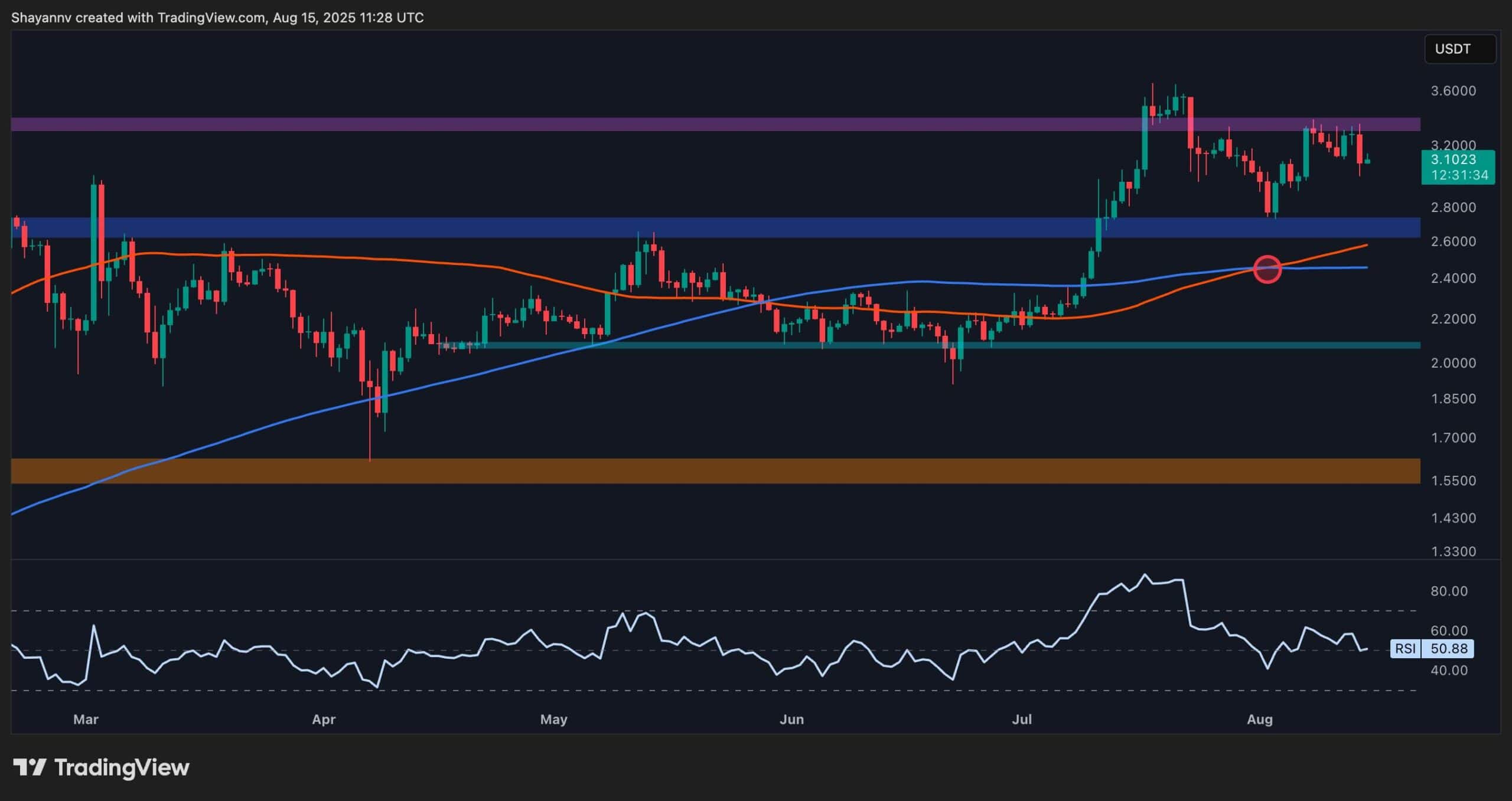Cryptocurrency
Garbled Circuits 101: What Could They Enable for Blockchain Privacy?

Blockchains were originally designed to be transparent, with every wallet and transaction on public display. Many supporters see this ‘trustlessness’ as a strength, but there are some obvious drawbacks, such as the security risk of having all of your financial activity available on-chain.
We can see this in the rates of illicit activity around blockchain, with bad actors accounting for $39.6bn of transaction volume in 2022.
We are also seeing a growing tactic of frontrunning for personal gain, where users with the technical skills to do so, reorder trades before they are committed to a block. By doing this they can ensure their own trades are always profitable.
These are just two examples of why transparency is often seen as a bug, and it’s also why the search for blockchain privacy is heating up. We are now seeing a flurry of innovation within the ecosystem to push for privacy solutions, arguably the last frontier for blockchain.
Blockchain Privacy Solutions
You may already be familiar with Zero-Knowledge proofs or ZKPs, one of the first blockchain privacy solutions to gain widespread adoption. ZKPs allow data to be shared between two parties without revealing any sensitive information. However, they fall short when handling more complex computations.
In many instances blockchain applications need multiple parties to compute solutions together, known as Multi Party Computation (MPC). This is where Fully Homomorphic Encryption (FHE) came into play. About four years ago, FHE emerged as an elegant solution to solve the MPC problem. FHE enables multiple parties to carry out computations on encrypted data without needing to disclose or know the underlying data points in order to retrieve the end result. However, FHE faces significant scaling issues given its high computing costs.
Garbled Circuits, High-speed, Lightweight Blockchain Privacy
Garbled Circuits – a technology developed by Soda Labs and implemented exclusive by COTI – aims to solve the MPC problem with much lower costs to run and far better performance.
In essence Garbled Circuits can be used to make confidential multi-party computations of varying complexity with any number of participants providing inputs. This makes it suitable for complex applications on blockchain protocols including private smart contracts. However, tweaks to the technology today mean that it is less computationally intensive, giving it the ability to scale.
How do Garbled Circuits work?
The concept of Garbled Circuits actually dates back to the late 80s, when it was proposed as a solution to Yao’s Millionaires’ Problem by famous cryptographer Andrew Yao. Imagine that there are two millionaires, Alice and Bob, who want to know who between the two of them has more money. The problem is that no one wants to reveal how much they have exactly. Instead of revealing the amount of money each of them has, they can solve their dispute with the help of Garbled Circuits.
Alice and Bob each write down their net worth in encrypted text, as a string of letters and numbers. Both of them put this piece of paper into a black box, and after a split second, a piece of paper is ejected with the name of the richer person. In this example, the black box is the Garbled Circuit, a powerful computer program that can perform complex calculations on encrypted data without leaking any information.
Garbled Circuits introduce new levels of confidentiality to Web3, protecting data and metadata to enable confidential payments, private/blind auctions and the secure management of sensitive information on-chain without sacrificing performance. COTI has demonstrated the technology’s effectiveness ahead of its integration with Ethereum-based Layer-2 network, COTI V2, which launched in April.
Web3 Use Cases for Garbled Circuits
As blockchain applications grow more complex, a privacy solution is needed that can handle secure MPC without any limit to the number of inputs. In these instances, Garbled Circuits have huge potential.
Confidential DeFI: Garbled Circuits enable confidential transactions, allowing Decentralized Finance (DeFi) apps to maintain regulatory requirements while solving losses from MEV by encrypting transaction data, shielding them from sandwich bots. Just some of the DeFi use cases of GC include private Automated Market Makers (AMMs), undercollateralized lending, dark pools and hybrid exchanges. These can leverage both centralized and decentralized elements while keeping trade details confidential.
Dynamic Decentralized Identification (DID): Garbled Circuits facilitate identity verification and personal information sharing, calculation, and storage without revealing actual data to other parties, ensuring KYC compliance while maintaining user privacy. For instance, decentralized lenders can now establish someone’s suitability for a loan without the individual exposing their wallet address or personal information. The GC breakthrough preserves privacy whilst fulfilling regulatory requirements.
On-Chain Sensitive Data Management: Garbled Circuits allow for encrypted data storage on-chain, enabling analysis of sensitive information without compromising privacy. Data can be safely shared across sites, preventing companies from scraping and selling it. Some of the applications that become possible include confidential on-chain voting systems and healthcare services. By storing encrypted data on-chain, GC satisfies stringent data protection standards whilst still providing the benefits of blockchain data storage and analysis.
One of the main characteristics of Garbled Circuits is their efficiency. Benchmark tests have shown that Garbled Circuits are much faster, lighter and cost-effective than any other privacy-preserving technology available today. This makes GC highly scalable, ensuring that the technology can grow alongside expanding markets such as Real World Assets (RWA) and Artificial Intelligence (AI).
Confidential Transactions for Payments, Stablecoins and RWA. Garbled Circuits maintains fund flow transparency while encrypting transaction details, ensuring regulatory compliance for payments, stablecoins, and real-world assets (RWA). RWAs include assets like real estate, commodities and securities that require high levels of privacy. GCs ability to ensure privacy, meet regulatory requirements, enhance security, and scale efficiently makes them an ideal choice.
Confidential Machine Learning & AI. Garbled Circuits also enables secure, private interactions with AI and large language models (LLMs), safeguarding data model confidentiality and data source privacy as required by law. GC can be used to enable decentralized and democratic ML model development and opens up new possibilities for privacy-focussed data marketplaces allowing researchers and businesses to work with datasets without exposing sensitive information.
Summary
To summarize, Garbled Circuits are revolutionizing privacy in blockchain applications, offering solutions that cater to various sectors, including DeFi, identity management, sensitive data handling, and AI. With their increased performance and scalability over other privacy solutions like FHE, Garbled Circuits are set to play a pivotal role in the future of Web3.
Authored by: Shafah Ban-Geffen, CEO and CO-Founder of COTI
Binance Free $600 (CryptoPotato Exclusive): Use this link to register a new account and receive $600 exclusive welcome offer on Binance (full details).
LIMITED OFFER 2024 at BYDFi Exchange: Up to $2,888 welcome reward, use this link to register and open a 100 USDT-M position for free!
Cryptocurrency
Ethereum Foundation, Whales, and Hackers: What’s Driving the ETH Sell-Off?

TL;DR
- Whales, hackers, and the Ethereum Foundation wallets moved over $500M in ETH through large sales and withdrawals.
- Ethereum transfers rose to 4.6M ETH, nearing the monthly high of 5.2M recorded in July.
- Staking inflows hit 247,900 ETH, the highest in a month, locking more supply from trading.
Large Withdrawals and Whale Activity
Ethereum (ETH) has seen heavy movement from major wallets over the past few days. On-chain data from Lookonchain shows a newly created wallet pulled 17,591 ETH, worth $81.62 million, from Kraken in just two hours.
Over three days, two new wallets withdrew a combined 71,025 ETH, valued at $330 million, from the exchange.
One of these wallets, address 0x2A92, has withdrawn 53,434 ETH, worth $242.34 million, in two days. This includes a recent purchase of 30,069 ETH, valued at $138.46 million, during a market drop.
Major ETH Holders Offload Millions Amid Price Rally
In contrast, several separate entities have been disposing of some ETH holdings. A wallet tied to a hacker address 0x17E0 sold 4,958 ETH for $22.13 million at $4,463, securing a profit of $9.75 million. Earlier this year, the same address sold 12,282 ETH at $1,932 and later bought back part of the amount at higher prices.
A different whale sold 20,600 ETH for $96.55 million over the past two days, generating a profit of more than $26 million after holding the position for nine months.
Meanwhile, an Ethereum Foundation-linked wallet, 0xF39d, sold 6,194 ETH worth $28.36 million in the last three days at an average price of $4,578.
Recent sales from the same wallet included an additional 1,100 ETH and 1,695 ETH for over $12.7 million combined.
The #EthereumFoundation-linked wallet(0xF39d) sold another 1,300 $ETH($5.87M) at $4,518 ~11 hours ago.
Over the past 3 days, this wallet has sold a total of 6,194 $ETH($28.36M) at an average price of $4,578.https://t.co/4hfCWymHVG pic.twitter.com/ErUyEY8SJy
— Lookonchain (@lookonchain) August 15, 2025
Network Activity on the Rise
CryptoQuant data shows Ethereum’s total tokens transferred have been climbing since August 9. After ranging between 1 million and 3 million ETH through late July and early August, transfers have risen to 4.6 million ETH, approaching the monthly high of 5.2 million recorded in mid-July. This increase has occurred alongside a price rally from about $3,400 to $4,600.
Interestingly, staking inflows generally stayed between 20,000 and 80,000 ETH per day over the past month. On August 14, inflows jumped to 247,900 ETH, the highest in the period.
At the time, ETH was trading near $4,600. Large staking deposits reduce the amount of ETH available for immediate trading, as staked coins are locked for a set period.
In the meantime, ETH trades at $4,647 with a 24-hour volume of $68.25 billion, down 2% on the day but up 19% over the week.
Binance Free $600 (CryptoPotato Exclusive): Use this link to register a new account and receive $600 exclusive welcome offer on Binance (full details).
LIMITED OFFER for CryptoPotato readers at Bybit: Use this link to register and open a $500 FREE position on any coin!
Cryptocurrency
Massive DOGE Whale Activity Hints at $1 Breakout

TL;DR
- Whales bought two billion DOGE this week, lifting their combined holdings to 27.6 billion coins.
- A single 900M DOGE transfer worth $208M to Binance drew attention to large exchange movements.
- DOGE broke key resistance, with momentum building for a possible push toward the $1 price mark.
Price and Market Moves
Dogecoin (DOGE) traded at $0.23 at press time, slipping 4% over the past day but still showing a 2% gain for the week. Daily turnover came in at about $6.18 billion.
Meanwhile, the broader crypto market saw over $1 billion in liquidations. Hotter-than-expected US Producer Price Index data pushed traders to scale back expectations of a near-term Federal Reserve rate cut. DOGE had roughly 290,500 coins liquidated during the sell-off.
On the two-week chart, analyst Trader Tardigrade notes that DOGE has cleared a downward-sloping resistance line after completing what appears to be a “wave V” in an Elliott Wave sequence. Similar setups in the past, where prolonged declines stayed within falling channels before breaking higher, have been followed by sharp rallies.
$Doge/2-week#Dogecoin is gaining strong momentum to surge above $1 pic.twitter.com/TuSEKr19nv
— Trader Tardigrade (@TATrader_Alan) August 15, 2025
Momentum gauges are also turning up. The Stochastic RSI, which had dropped into oversold territory, is now heading higher. Previous reversals from this zone have coincided with sustained upward moves. The current formation points to a possible run that could carry DOGE past the $1 mark.
Heavy Whale Buying and Large Transfers
As reported by CryptoPotato, blockchain data shows large investors have added two billion DOGE in the past week, spending just under $500 million. That brings their holdings to about 27.6 billion coins, or 18% of the supply. The buying streak has prompted speculation within the community.
Recently, Whale Alert flagged a 900 million DOGE transfer worth about $208 million into Binance. The tracking indicates that it originated from a wallet connected to the exchange, likely as an internal activity. The address involved holds 2.88 billion DOGE, one of the largest balances on the network.
Ali Martinez also reports that transactions above $1 million reached a one-month high, with activity building since early August and peaking as DOGE traded at $0.25.
Whales are back! Dogecoin $DOGE activity at a 1-month high. pic.twitter.com/C83Pv68mCt
— Ali (@ali_charts) August 14, 2025
Sentiment Building
Analyst Gordon described the current setup as “a nice bit of consolidation” before a potential breakout, adding,
“This will be one of the first coins normies FLOCK to & the pump will be MASSIVE.”
With whale accumulation rising, high-value transfers increasing, and a bullish technical pattern in play, DOGE is positioned for a potential push toward $1 if momentum holds.
Binance Free $600 (CryptoPotato Exclusive): Use this link to register a new account and receive $600 exclusive welcome offer on Binance (full details).
LIMITED OFFER for CryptoPotato readers at Bybit: Use this link to register and open a $500 FREE position on any coin!
Cryptocurrency
Ripple Price Analysis: XRP at Risk as Key Support Levels Could Trigger Sharp Drop

XRP has recently entered a consolidation phase after a strong rally earlier this summer, with the price action now hovering around key resistance levels on both its USDT and BTC pairs. Yet, while momentum has slowed, the charts still indicate a generally bullish structure, with multiple key support levels remaining firmly in place.
Technical Analysis
By ShayanMarkets
The USDT Pair
On the XRP/USDT daily chart, the price is currently trading near the $3.10 mark, facing a strong resistance zone around $3.40. This follows a breakout above the $2.70 range in July, which has now flipped into a support area.
Both the 100-day and 200-day moving averages are also trending upward and recently formed a bullish crossover around $2.45, reinforcing the medium-term bullish sentiment. If the $3.40 resistance breaks, a push toward the critical $4.00 range becomes likely.
However, the RSI hovering near the neutral 50 level suggests a lack of strong momentum for now, meaning a short-term pullback into the $2.80 support zone is still possible.
This zone will be key for maintaining the bullish structure. Losing it could open the door for a deeper correction toward the 200-day moving average located around the $2.40 mark. Yet, as long as the price stays above the moving averages, the broader trend remains bullish.
The BTC Pair
Looking at the XRP/BTC chart, the pair has recently pulled back after hitting the 3,000 SAT resistance, with the price currently around 2,600 SAT.
This follows a clean breakout above the long-term descending channel and a successful retest of its upper boundary, which coincided with the 200-day moving average and the 2,400 SAT support zone. This confluence remains a key bullish technical factor, as holding above it could attract renewed buying pressure.
That said, RSI levels around 48 show that momentum has cooled after the sharp July rally, meaning XRP may continue ranging between 2,400 SAT and 3,000 SAT in the near term. A decisive close above 3,000 SAT would likely open the path to the 3,400 SAT zone, while losing 2,400 SAT could shift the bias back toward 2,000 SAT support. For now, the structure still favors the bulls as long as higher lows remain intact.
Binance Free $600 (CryptoPotato Exclusive): Use this link to register a new account and receive $600 exclusive welcome offer on Binance (full details).
LIMITED OFFER for CryptoPotato readers at Bybit: Use this link to register and open a $500 FREE position on any coin!
Disclaimer: Information found on CryptoPotato is those of writers quoted. It does not represent the opinions of CryptoPotato on whether to buy, sell, or hold any investments. You are advised to conduct your own research before making any investment decisions. Use provided information at your own risk. See Disclaimer for more information.
Cryptocurrency charts by TradingView.

 Forex3 years ago
Forex3 years agoForex Today: the dollar is gaining strength amid gloomy sentiment at the start of the Fed’s week

 Forex3 years ago
Forex3 years agoUnbiased review of Pocket Option broker

 Forex3 years ago
Forex3 years agoDollar to pound sterling exchange rate today: Pound plummeted to its lowest since 1985

 Forex3 years ago
Forex3 years agoHow is the Australian dollar doing today?

 Cryptocurrency3 years ago
Cryptocurrency3 years agoWhat happened in the crypto market – current events today

 World3 years ago
World3 years agoWhy are modern video games an art form?

 Commodities3 years ago
Commodities3 years agoCopper continues to fall in price on expectations of lower demand in China

 Economy3 years ago
Economy3 years agoCrude oil tankers double in price due to EU anti-Russian sanctions





















